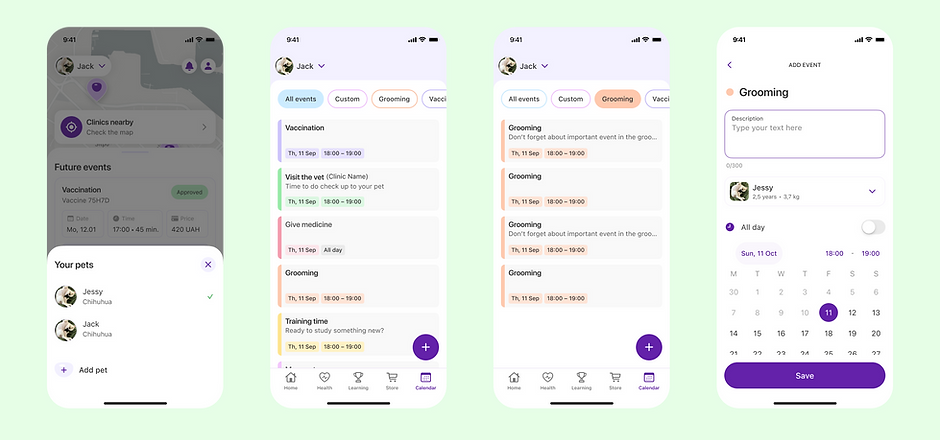Bubibo
From 2023 to Present
Bubibo is a smart ecosystem that makes it easy for pet owners and vet clinics to stay connected. Pet owners get a handy tool to track and store their pet’s health records, while clinics can manage their work more smoothly — all in one place.

Bubibo App
📌 The Overview
Bubibo combines a personal pet profile, medical records, health tracking, and educational programs in one app. Its goal is to simplify interactions between pet owners, veterinary clinics, and care systems, while promoting healthy habits and providing daily support in pet care.
🎯 My Key Focus Areas
I joined the team at the idea stage - we had just visual guidelines, a general understanding of the concept, and the product's key goals. From there, I took full responsibility for designing the product from the ground up - from strategy and UX to building the UI system and delivering final design mockups for development.
🧠 Research and Design Kickoff
My first step was conducting interviews with stakeholders to clarify the product vision and expectations for the MVP. At the same time, I carried out market and competitor analysis — exploring existing solutions, the problems they address, and which UX/UI practices we can use.
Based on these insights, I developed the information architecture, created the app map, and defined the core features for the first version.

✍️ UX Design and User Flows
Before finalizing the visual style, I focused on UX design - creating low-fidelity prototypes, mapping out key user scenarios, and building navigation logic. This early-stage work made it possible to align and test the app’s architecture before moving into detailed design.
🎨 Visual System Development
The visual identity of the product was created from scratch. We developed and tested several UI concepts before selecting the most viable one.
I designed a UI kit based on atomic design principles and platform-specific guidelines. This became the foundation for a scalable design system moving forward.
📱 Key Screens and Launch
During the first year, I independently designed and delivered the core sections of the app for development, including:
-
Onboarding and registration
-
User and pet profiles
-
Educational courses and programs
-
Payment and subscription flow
-
Pet medical records (visits, tests, diagnoses, procedures, payments)
We successfully published the app in stores, attracted our first audience, and gathered feedback from real users as well as behavioral data.
🔁 Product Improvement Based on Data
After launch, I analyzed user behavior, collected and organized feedback, identified pain points, and formed a pool of hypotheses.
At this stage, we:
-
Revisited and improved UX solutions
-
Refined the flows for educational courses and payments
-
Made structural adjustments to the pet’s medical records

Bubibo Vet
📌 The Overview
Bubibo Vet is a SaaS system designed to automate processes in veterinary clinics. The system covers key functions - from appointment scheduling and animal check-ins to inventory management, staff administration, finance, and integration with external services. The product is tailored for various user types: administrators, veterinarians, groomers, and sales staff.
🎯 My Key Focus Areas
I joined the project at its very early stages, before the final MVP functionality was clearly defined. My responsibilities included researching user needs, designing UX and business logic and implementing design processes.
🧠 Research and MVP Definition
Together with the product manager, we conducted a series of interviews with veterinarians and clinic staff. This helped us gain a clear understanding of user needs and define the MVP scope to cover the basic scenarios for different roles.Knowing that the product would be used by diverse audiences with varying contexts and goals, we developed multiple user personas and made design decisions based on their specific needs.
✍️ UX Design and Planning
Visual elements were not the primary focus for this product, so we prioritized simplicity and efficiency in user flows. Once the development team finalized the tech stack, we adapted an existing UI kit, which significantly sped up the launch process.Design work was closely coordinated with the product manager, analysts, and developers. We established a structured design process including solution preparation and approval, handoff to development, and implementation support.
🔧 Systematizing Work and Addressing UX Debt
At the start, I created a structured design backlog with a tagging system for future improvements, refactoring, and UX debt resolution. This enabled the team to efficiently navigate tasks and implement UX enhancements alongside core features moving forward.
📊 Research Methods and Data Analysis
At the early stage, we relied on qualitative methods such as interviews, user testing, and competitor analysis. As the user base grew, we incorporated quantitative metrics, providing a more scalable view of user behavior and enabling us to prioritize features more accurately.

📦 Implemented Functionality
During my work, we designed and delivered:
-
Appointment scheduling, animal check-in, and clinic record management
-
Client, pet, staff, and schedule management system
-
Financial modules: invoicing, payments, and reporting
-
Inventory and stock management
-
Analytical reports Integrations with third-party services (payment systems, cash registers, telephony, notifications)
🔁 Feedback Management and Iterative Improvements
After the MVP launch and onboarding our first clients, we implemented a feedback collection system through customer support and direct interviews.
This enabled us to:
-
Quickly identify and resolve problem areas
-
Formulate hypotheses and prioritize enhancements
-
Improve product quality based on real-world usage
The product evolved both broadly (adding new features) and deeply (refining and optimizing UX), while remaining tailored to the everyday needs of veterinary clinics.